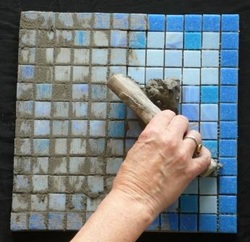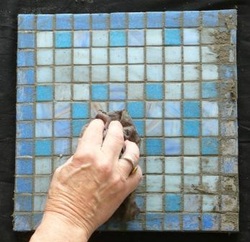Home
›
Getting Started
›
Grout
Grout
Grout is the material that brings the whole piece together; it enhances the overall look of the piece.
It is a cement based product that is used to fill the gaps between the tesserae. There are two types of grout: sanded and unsanded.
Unsanded is only used when the gaps between the tesserae are 3mm or less. If unsanded is used in larger gaps it will crack.
You can purchase grout ready mixed but I prefer to use the powdered form that is mixed with water. It can be purchased at all Home Improvement stores.
Grout comes in a variety of colours but you can create your own distinct colour by adding acrylic paint or oxide tints. The colour choice is an important feature of any mosaic. Grey is my most preferred colour as it is a neutral colour so the mosaic piece is viewed more as a whole. Black grout will create a dramatic effect and tends to draw the eyes to the grout lines. White will do the opposite so that the eyes are drawn more to the individual tesserae.
How to Mix and Apply Grout
You will need:
Powered grout
Water
A container – I find that a round plastic bowl works best
A dust mask and gloves
A stirring tool – an old spoon is good
A spreading tool – depending on your mosaic – if it is flat then you can use a squeegee – if it is not flat then use a sponge or your fingers but be sure to protect them with gloves.
Foam sponges
Soft cloth
Newspaper to spread over your working area
Bucket with water to rinse out the foam sponges
Here’s How
1. Prepare – spread newspaper over your work space. Assemble your tools and supplies.
2. Mix – pour grout into the bowl and begin to add water. A little at a time.
Grout is like icing sugar, if you add too much water you have to add more icing sugar.
Stir, adding small amounts of water until the grout is the consistency of peanut butter. Do not over stir because you do not want to add air bubbles into the grout.
3. Leave it to slake. The grout needs approximately 10 minutes for the chemical reaction to take place.
4. After 10 minutes stir once more.
It is a cement based product that is used to fill the gaps between the tesserae. There are two types of grout: sanded and unsanded.
Unsanded is only used when the gaps between the tesserae are 3mm or less. If unsanded is used in larger gaps it will crack.
You can purchase grout ready mixed but I prefer to use the powdered form that is mixed with water. It can be purchased at all Home Improvement stores.
Grout comes in a variety of colours but you can create your own distinct colour by adding acrylic paint or oxide tints. The colour choice is an important feature of any mosaic. Grey is my most preferred colour as it is a neutral colour so the mosaic piece is viewed more as a whole. Black grout will create a dramatic effect and tends to draw the eyes to the grout lines. White will do the opposite so that the eyes are drawn more to the individual tesserae.
How to Mix and Apply Grout
You will need:
Powered grout
Water
A container – I find that a round plastic bowl works best
A dust mask and gloves
A stirring tool – an old spoon is good
A spreading tool – depending on your mosaic – if it is flat then you can use a squeegee – if it is not flat then use a sponge or your fingers but be sure to protect them with gloves.
Foam sponges
Soft cloth
Newspaper to spread over your working area
Bucket with water to rinse out the foam sponges
Here’s How
1. Prepare – spread newspaper over your work space. Assemble your tools and supplies.
2. Mix – pour grout into the bowl and begin to add water. A little at a time.
Grout is like icing sugar, if you add too much water you have to add more icing sugar.
Stir, adding small amounts of water until the grout is the consistency of peanut butter. Do not over stir because you do not want to add air bubbles into the grout.
3. Leave it to slake. The grout needs approximately 10 minutes for the chemical reaction to take place.
4. After 10 minutes stir once more.

5. Spoon the grout onto your piece. Use the spreading tool to spread the grout into the gaps between the tesserae. Be sure to fill all the gaps.
6. Wipe off the excess grout from the top of the tiles using a dry foam sponge. Many people will tell you to use a damp sponge but if the sponge is too wet the grout will turn to mud. I find it is better to use a dry sponge. Keep turning the sponge over to use a clean side. When all sides have been used put it in the bucket of water and use a second sponge if necessary.
6. Wipe off the excess grout from the top of the tiles using a dry foam sponge. Many people will tell you to use a damp sponge but if the sponge is too wet the grout will turn to mud. I find it is better to use a dry sponge. Keep turning the sponge over to use a clean side. When all sides have been used put it in the bucket of water and use a second sponge if necessary.

7. Once all the excess grout has been removed from the top of the tiles wait for
approximately 10 minutes. The grout on the top of the tiles will begin to look
powdery, this is the time to polish using the soft cloth. Be careful not to drag the grout out from between the tesserae.
8. Wait an hour and give your piece a final buff.
Voila - done
approximately 10 minutes. The grout on the top of the tiles will begin to look
powdery, this is the time to polish using the soft cloth. Be careful not to drag the grout out from between the tesserae.
8. Wait an hour and give your piece a final buff.
Voila - done
Home
›
Getting Started
›
Grout

